As with any type of marketing campaign, Facebook ads and promotions are most successful when they’re targeted. Once you understand who your Facebook audience is, you’ll be better positioned to tailor content to them. Ultimately, this will help you realize higher engagement and conversion rates.
An introduction to Facebook audiences
With over two billion active daily users across the globe, Facebook is a platform packed with marketing opportunities. Perhaps this is why more than 87 percent of marketers in the U.S. alone plan to use it as a marketing tool in 2020.
Facebook ad campaigns can help you:
- Expand your reach
- Build brand awareness
- Increase sales
According to research, the average Facebook user clicks on 11 ads per month. This is a lot, and speaks to online shoppers’ affinity for pursuing promotions on the social platform. However, they’re not going to click on irrelevant ads. This is why identifying your Facebook audiences is a critical step in your social media marketing efforts.
Put simply, a Facebook audience is your target market. It refers to the users who are most likely to be interested in your offerings and, ultimately, lead to a conversion.
Facebook offers a wide range of tools to help you create more effective ad campaigns, one of those being the Audience Manager tool. With this, you can save audiences and create new ones.
The three main types of Facebook audiences are:
- Saved Audiences. These are audiences you can define based on peoples’ demographics, interests, income level, devices used, etc.
- Custom Audiences. This category of users can be incredibly valuable because you can retarget past customers and site visitors. You can create a Custom Audience based on website traffic, customer files, and engagement data.
- Lookalike Audiences. These are the people you can target based on the similarities they have with existing customers.
Creating Custom Audiences is one of the most valuable ways to target consumers. It lets you create highly defined groups of people who have already shown an interest in your brand, content, or offerings.
How to identify and target your Facebook audience (4 key tips)
Next, let’s see how you can find your own audience and use them for successful ad targeting. Let’s take a look at four key tips you can use for creating and using Facebook audiences.
1. Use Facebook Audience Insights to collect user data and build a customer persona
Facebook Audience Insights is a free tool that lets you gain a plethora of meaningful insights to improve your ad campaigns. Moreover, you can use it to learn about the people currently connected to (or engaging with) your Facebook page.
Audience Insights also makes it easier to create a customer persona or ‘user profile.’ You can identify common similarities between users, then use this information build targeted ads. The more familiar you are with your customer persona, the easier it will be to create highly specific audiences.
You can locate the Audience Insights section under your Facebook Ads Manager page. In the top-left corner, click on the hamburger icon. Then, under the Plan section, click on Audience Insights:

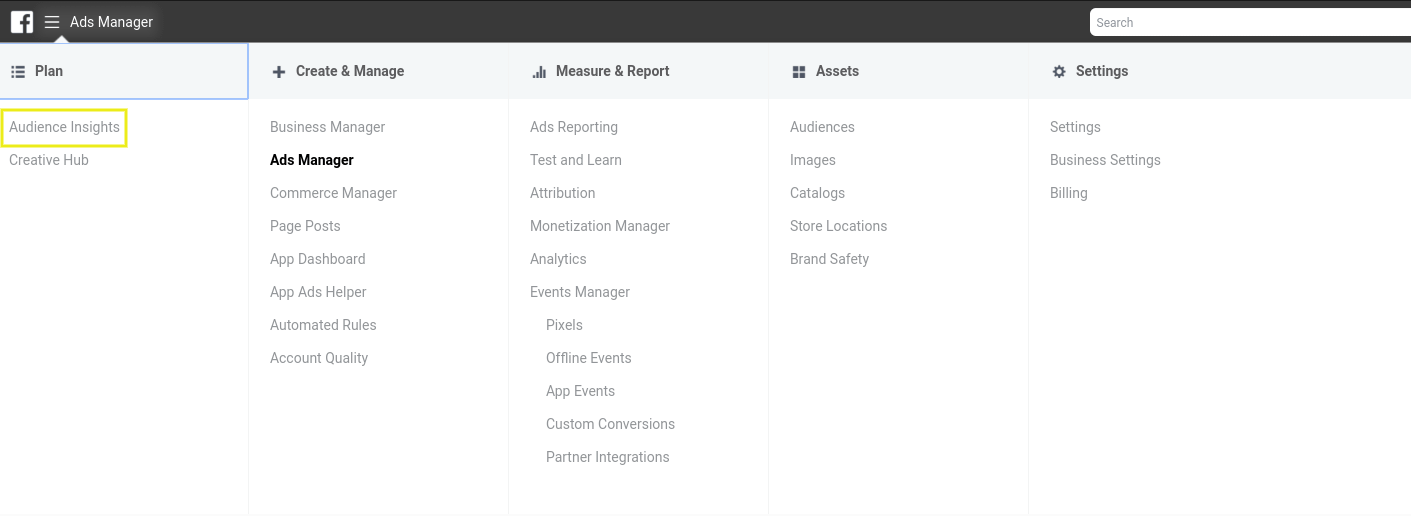
A pop-up window will appear presenting you with two options for analyzing an audience: Everyone on Facebook or People connected to your Page. If your Facebook page is relatively new, you may want to choose the first. It will then bring you to the Audience Insights page:

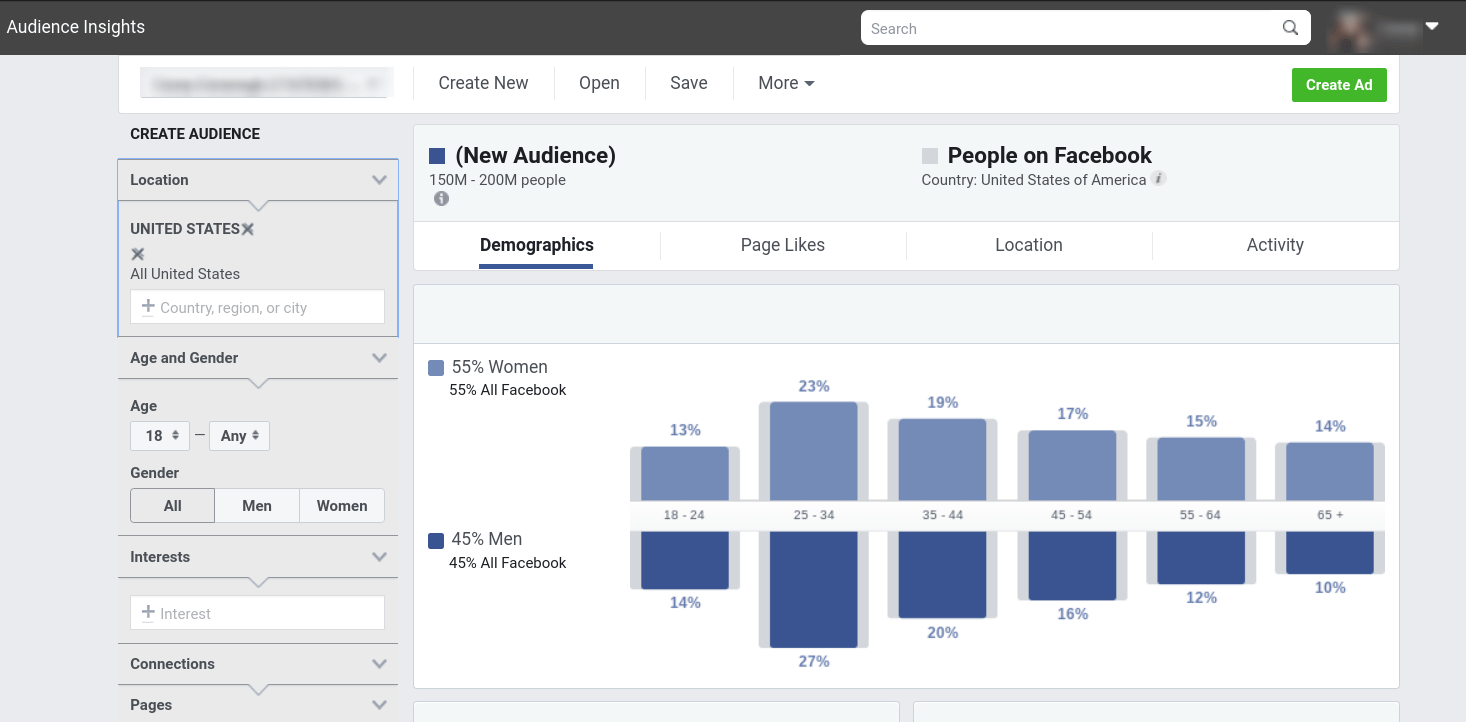
Here, you can view a wide range of data on Facebook users. This includes age, gender, and location. You can also select the Advanced option to gain even deeper insights:

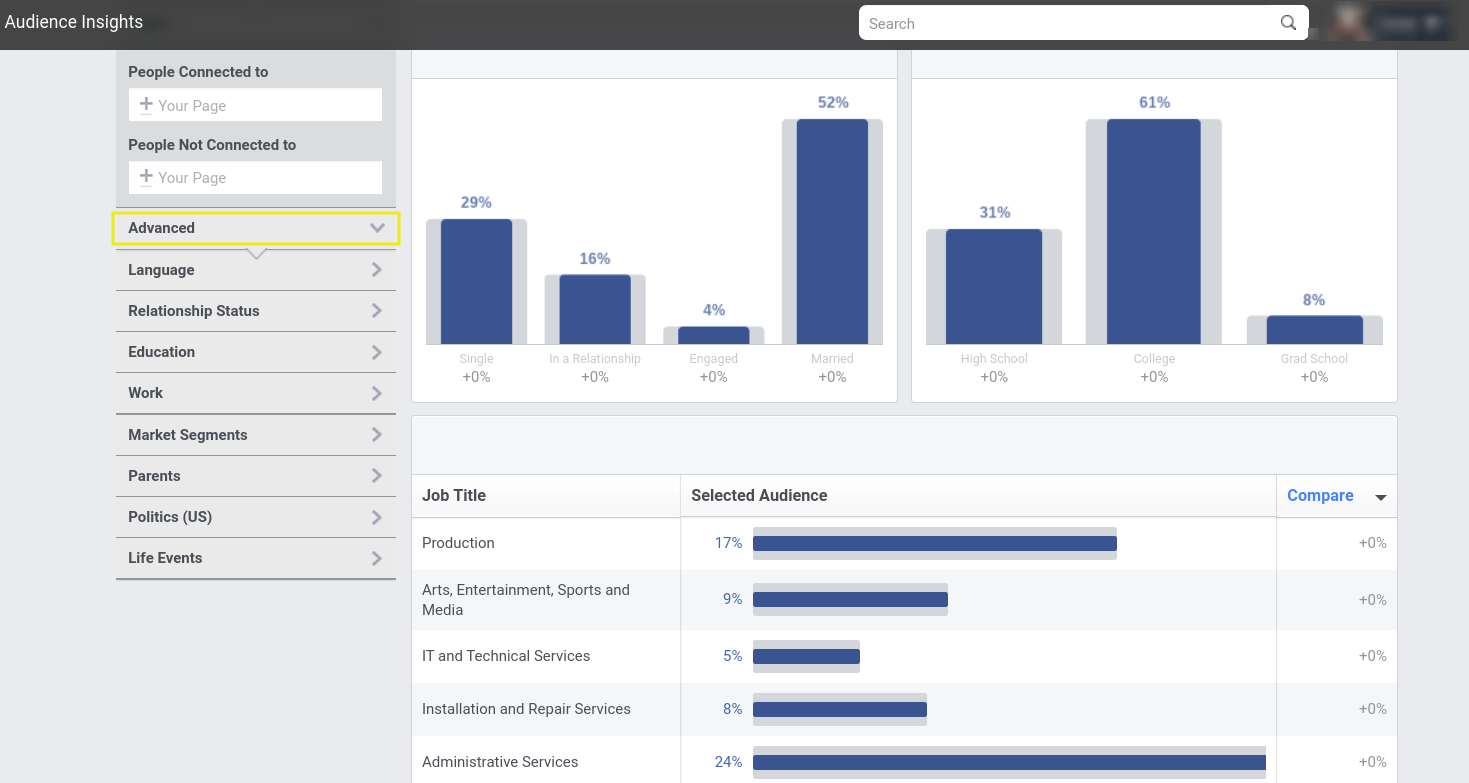
This includes everything from relationship status and language to occupation and education. You can also use this page to filter by Page Likes to uncover more user interests.
You can also save an audience based on these insights:

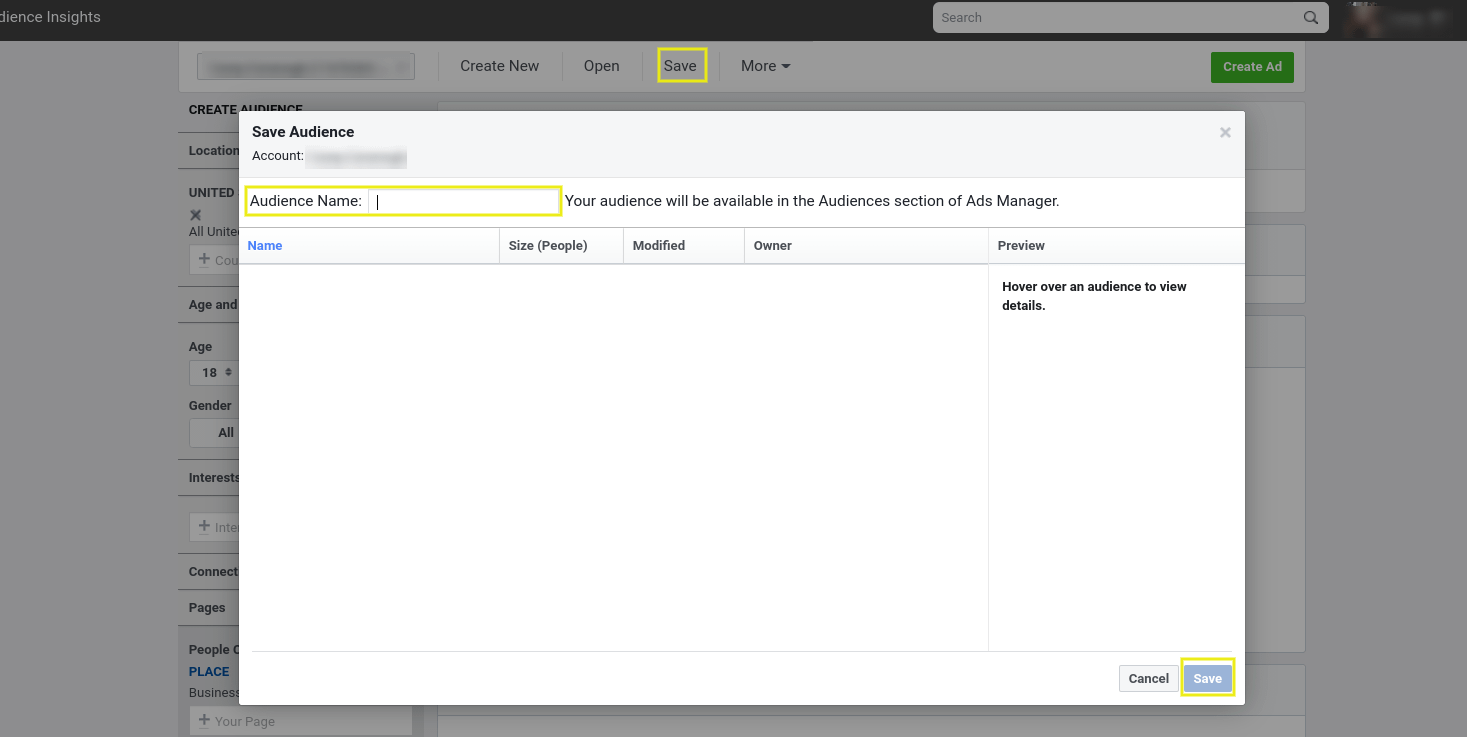
Simply click on Save at the top of the page, name the audience, then click on the Save button at the bottom.
2. Create a custom audience based on your website’s traffic
Another way you can create and target a Facebook audience is by retargeting your website visitors. The people who have visited your website already show an interest in your products. So, it makes sense to incorporate them into your Facebook audience and campaigns as well.
The easiest and most effective way of going about this is to add a Facebook Pixel to your website. This is a unique snippet of code that lets Facebook track your site data, including visitor behavior.
You can then use this information to optimize your audience and ads. For example, you can target Facebook ads toward consumers who abandoned their shopping cart on your site.
Facebook Pixel tracks ‘events’ that are based on visitor actions. There are a handful of standard events you can track, such as Add to Cart. You can also create custom events and build custom audiences for anything not covered by the standard events.
Once you’ve installed the Pixel on your website, you can create a custom audience based on the traffic. To do this, go to your Ads Manager page, click on the hamburger icon, then under Assets, select Audience. This will bring you to the Audience Manager page.
After you click on Create a Custom Audience, a window will open providing a number of sources to choose from. Click on Website:

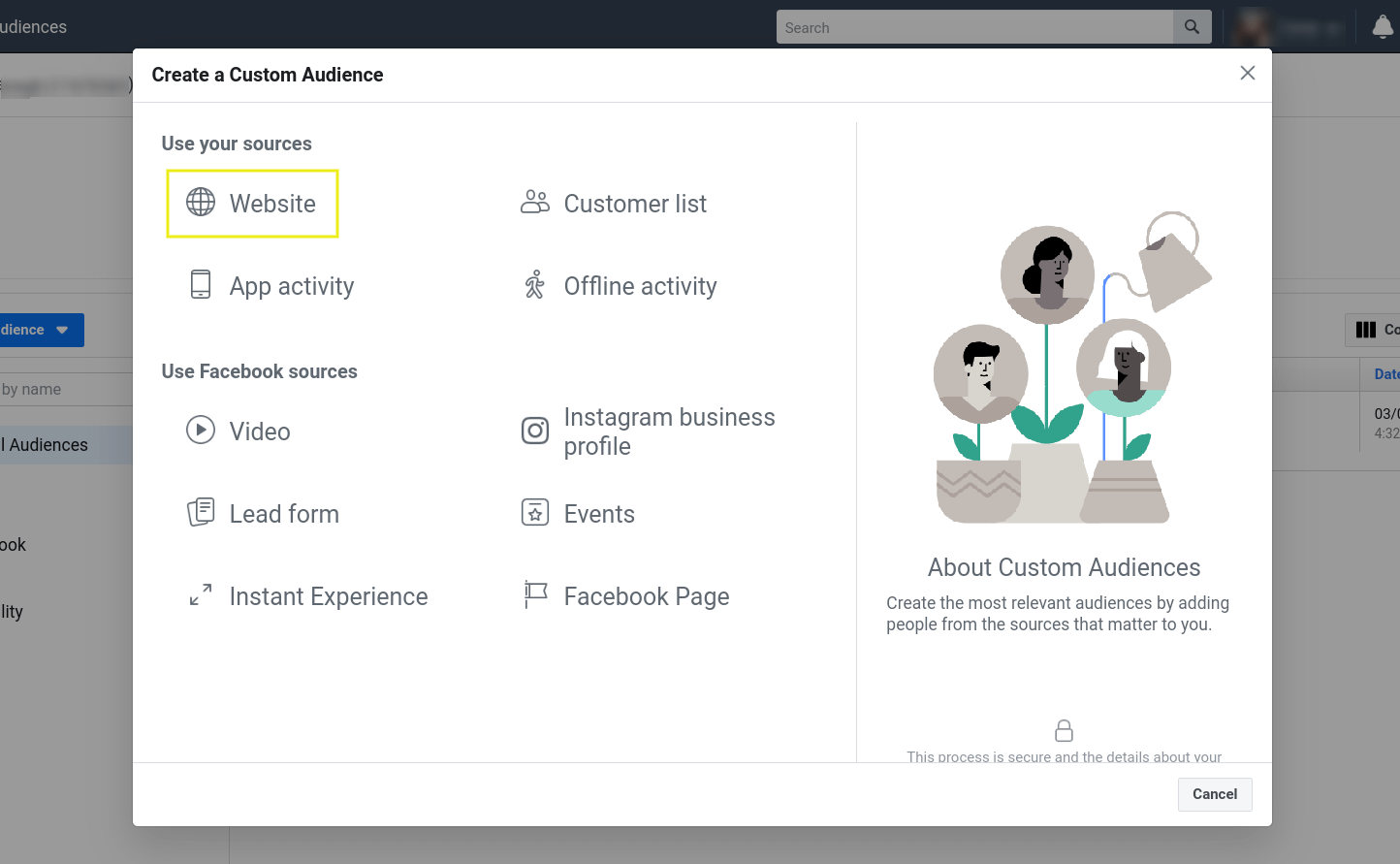
Next, you can configure the settings for your custom audience:

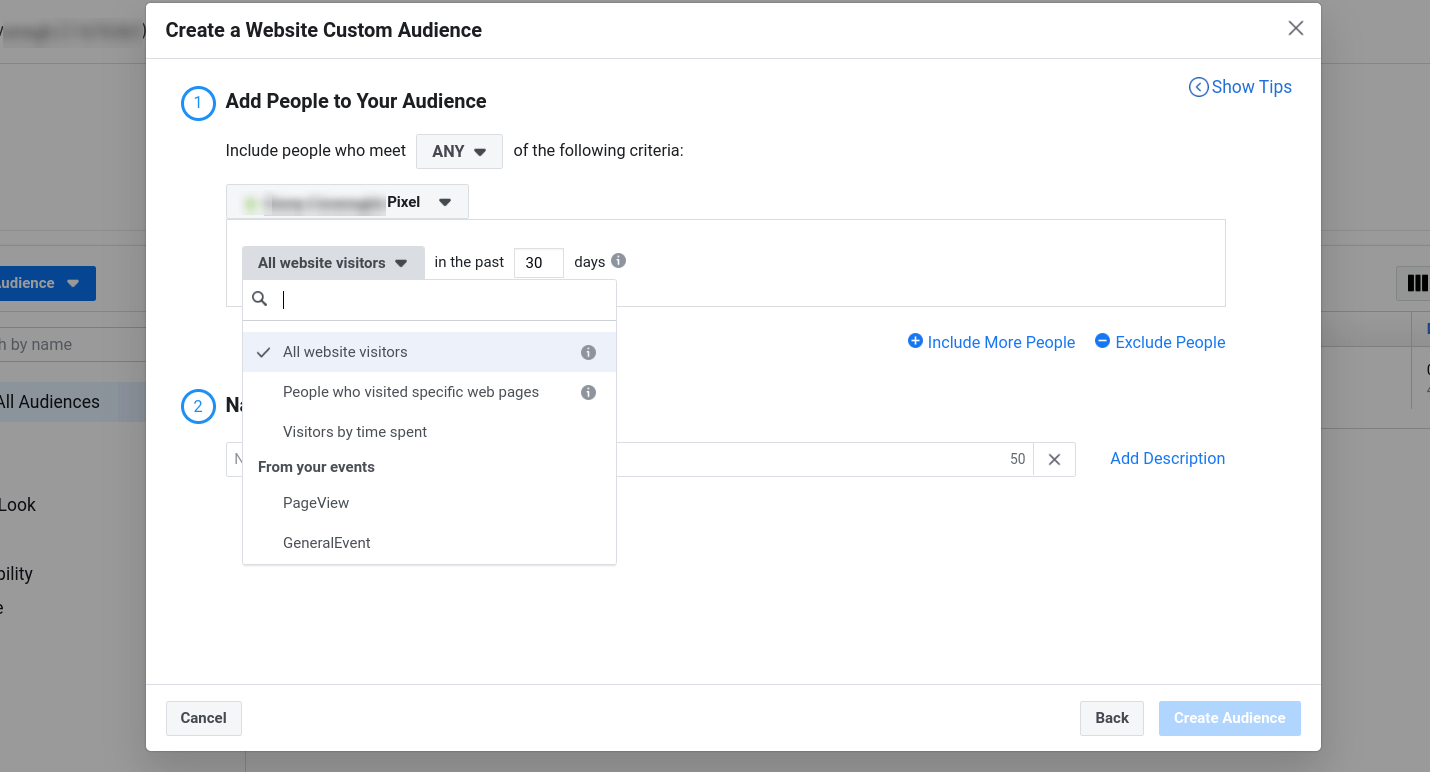
You can target:
- All visitors
- People who visited specific pages
- Visitors by time spent
When you’ve established the parameters, name the audience, then click on the Create Audience button. If the custom audience has at least 1,000 people, you can create a targeted ad for them.
3. Build a Facebook audience using your email or customer list
Your website traffic isn’t the only source you can use to create and target custom audiences. You can also use data from existing customer files, which might include emails, phone numbers, and addresses. Facebook uses the customer profile data to match it with Facebook profiles.
This is a recommended route if you’re an established business but are still somewhat new to Facebook advertising. It can help you bridge the gap between past, existing, and potential customers.
To do this, go to the Audience page of your Facebook Ads Manager, then click on Create Audience > Custom Audience. In the window that opens, select Customer list:

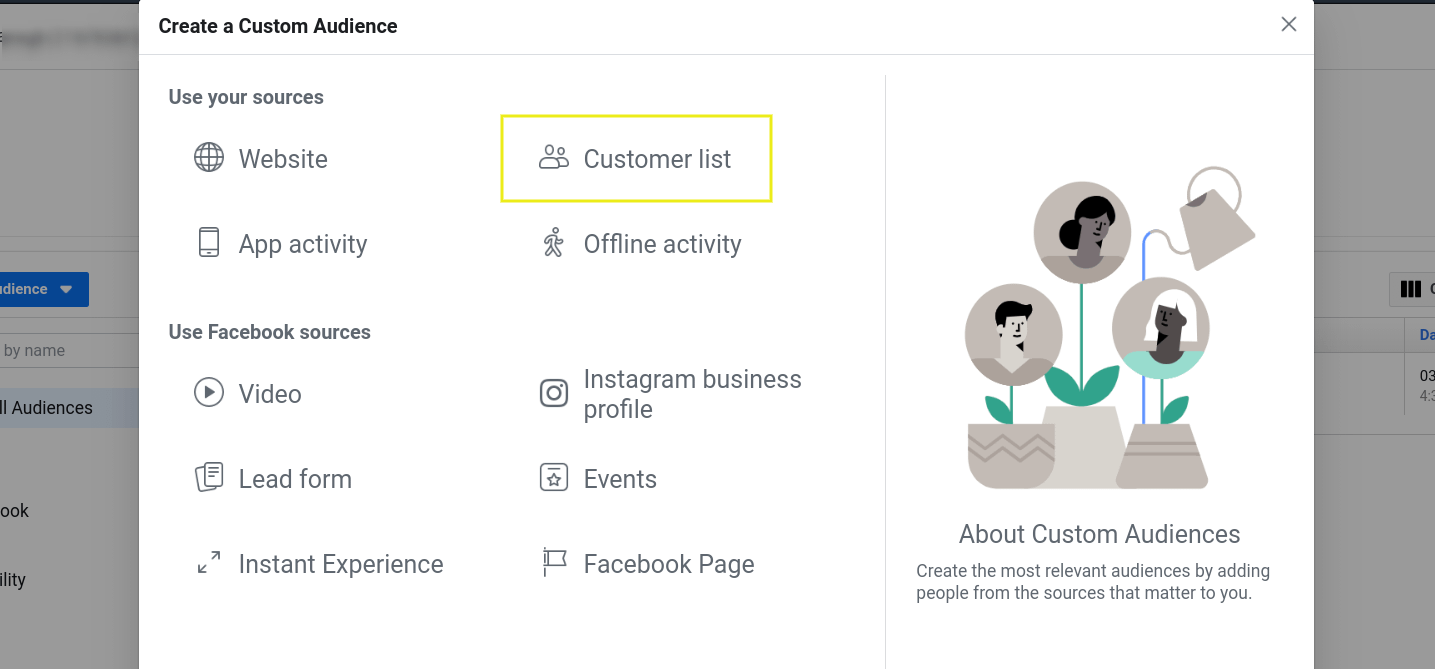
Next, it will explain the requirements for preparing your customer list:

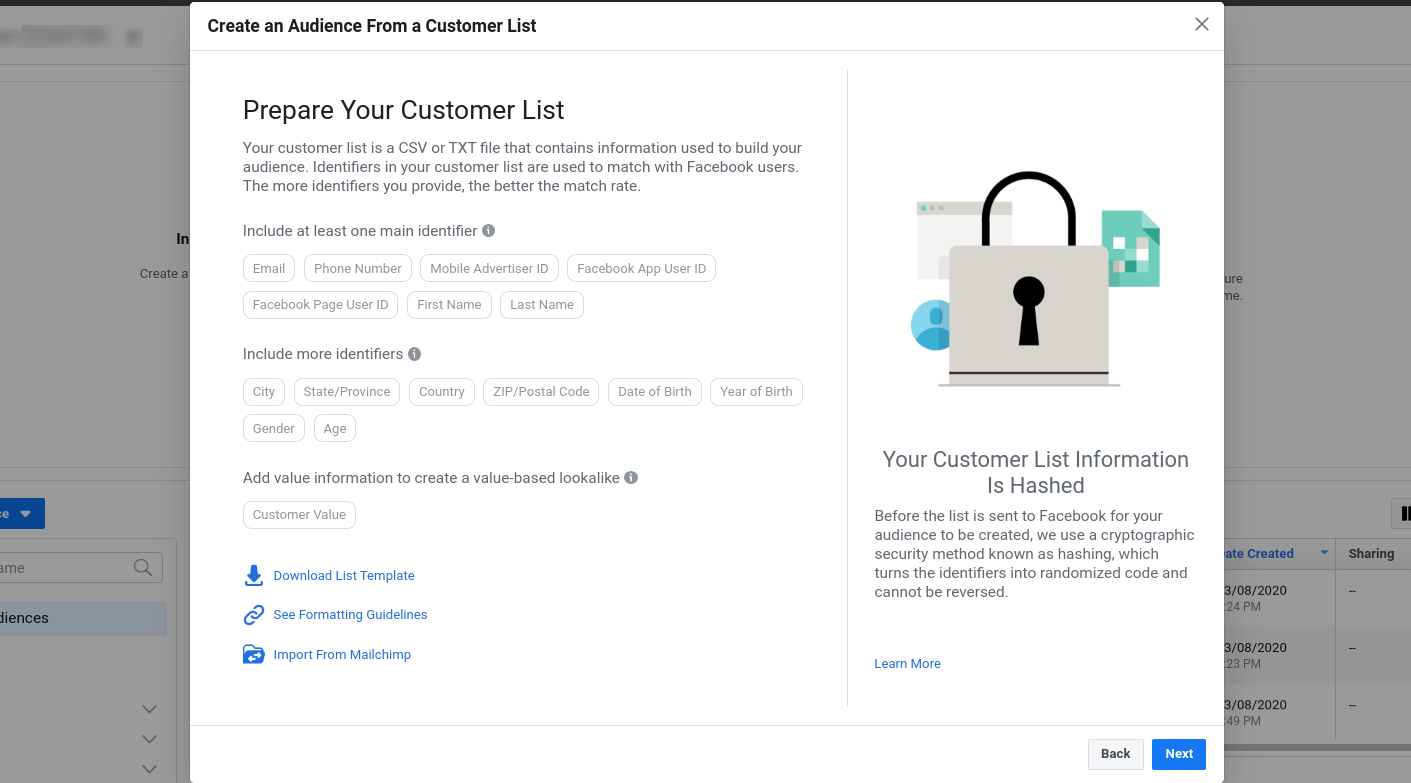
You can choose at least one identifier (such as email). Each identifier should have its own column in your customer list and be appropriately named. If you’re a Mailchimp user, you can import a list from there.
To upload your own, select the Next button. Agree to the terms, then click the Next button again.
It will bring you to the page where you can upload your own customer list:

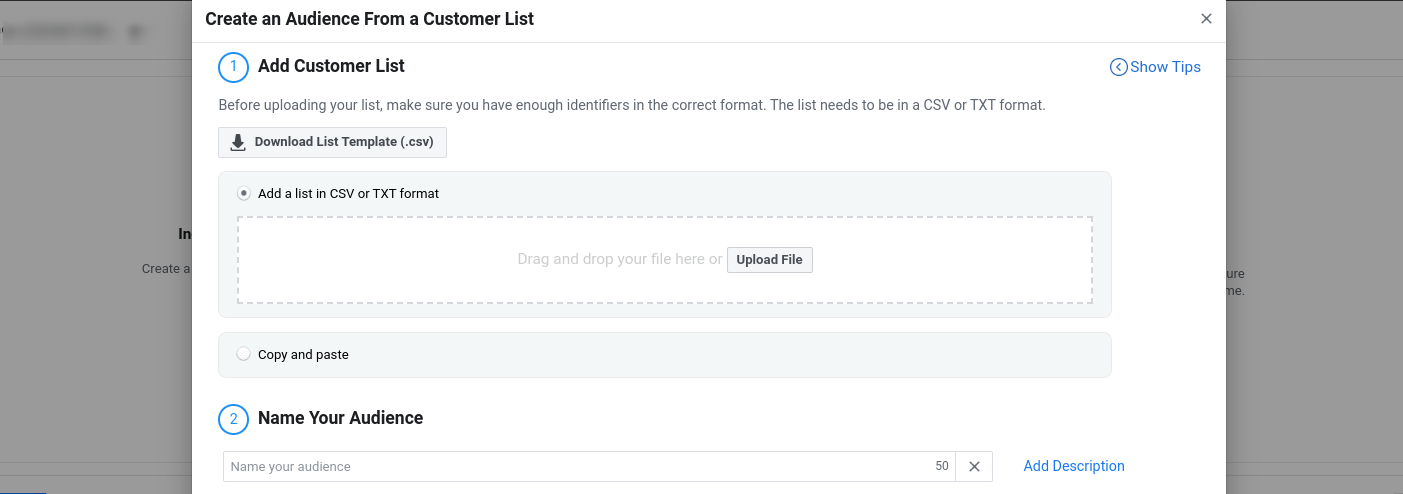
Note: It must be either a .CSV or .TXT file. After you upload and name the list, click on the Next button. It will bring you to a preview page so you can review the data mapping to ensure that it’s appropriately categorized:

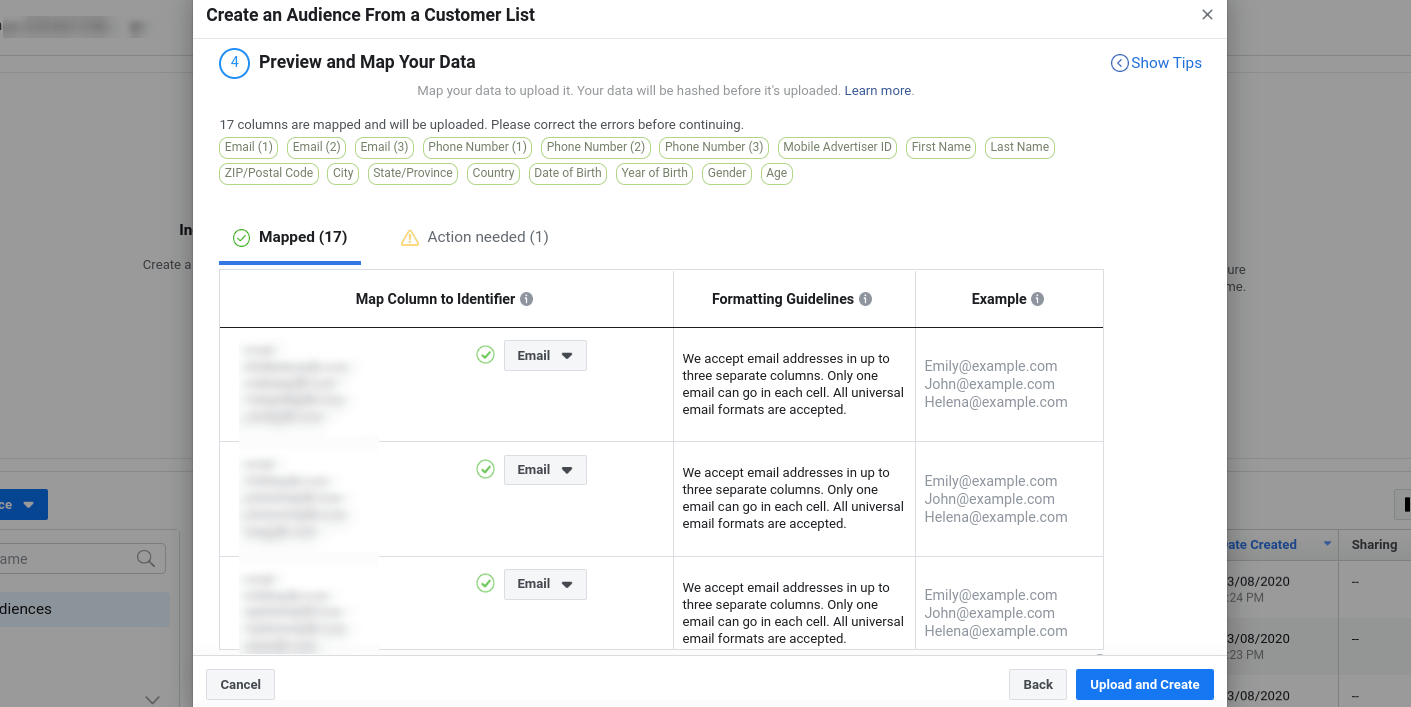
When you’re done, select Upload and Create. The custom audience will then be automatically added to your Audiences list.
4. Experiment with a Facebook lookalike audience
Once you’ve spent some time creating new custom Facebook audiences and are comfortable using them for targeted campaigns, you can expand your reach by experimenting with Lookalike Audiences. As you might recall, these refer to groups you can target based on similarities they share with your existing customers and audiences.
You can create a lookalike audience that uses your existing defined custom audience and extends it to incorporate various other metrics. For example, you could build a Lookalike Audience that includes the same interests as a saved audience, only in another region or country.
To create a Lookalike Audience, go to your Audiences page and click on Create Audience > Lookalike Audience. In the panel that opens, you can fill in the details to create your Lookalike Audience:

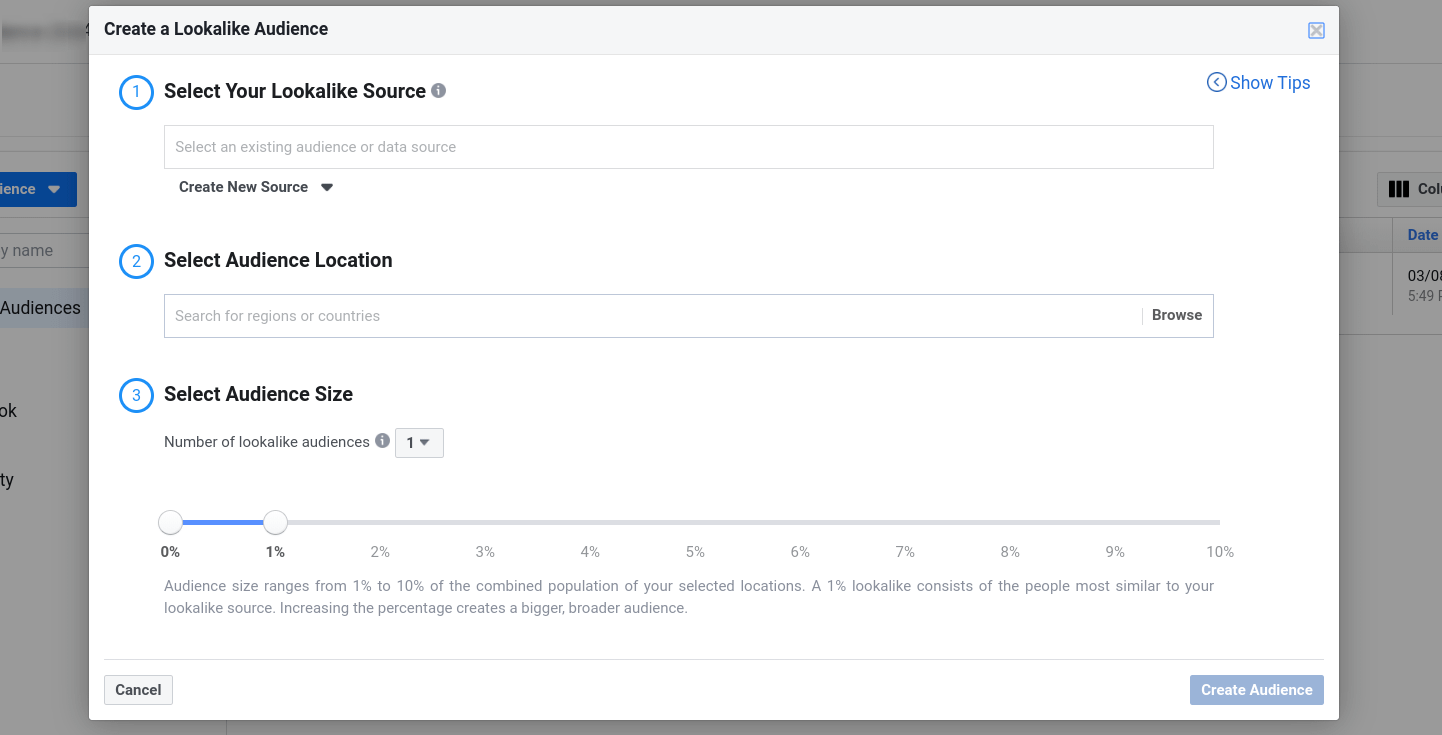
First, choose a ‘lookalike’ source. This can be an existing or saved audience or you can create a new one. Next, you can choose a new location to target as well as an audience size. The higher the size percentage, the broader the search will be. When you’re done, click on the Create Audience button.
Conclusion
Facebook is one of the most frequented websites on the planet, making it a goldmine for advertisers. However, to make the most of your advertising campaigns, it’s essential to make sure you’re targeting the users most likely to convert. On Facebook, these groups are referred to as ‘audiences’.
In this post, we covered four key tips you can use to identify and target your Facebook audience:
- Use Facebook Audience Insights to gather data and build a customer persona.
- Create a custom audience based on your website visitors.
- Build a Facebook audience using your email or customer list.
- Experiment with a Facebook Lookalike Audience.
Do you have any questions about uncovering and targeting your Facebook audience? Let us know in the comments section below!
The post How to Identify and Target Your Facebook Audience (4 Key Strategies) appeared first on Revive Social.